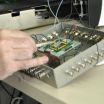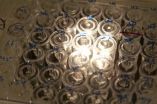Portrait of gambling behavior in Quebec
70 percent of Quebecers gamble; nearly 41,000 are pathological gamblers
2010-11-11
(Press-News.org) Montreal, November 10, 2010 – The initial findings of a survey on the prevalence of gambling in Quebec have been released. The study also deals with behavior problems associated with gambling. The study reveals that nearly 70 percent of Quebec adults report having bet or spent money on gambling during the previous 12 months. It also found Quebecers spend an average of $483 annually on gambling activities.
This survey was conducted between June and September 2009 throughout the province among 11,888 non-institutionalized adults over the age of 18. It constitutes the first stage of a project that will span a total of five years. These findings will support recommendations for prevention and treatment.
The study was led by researchers Dr.Sylvia Kairouz, director of Concordia University's Lifestyle and Addiction Research Laboratory and professor in the Department of Sociology and Anthropology and Dr.Louise Nadeau, co-researcher and scientific director at the Centre Dollard-Cormier, Institut universitaire sur les dépendances and professor in the department of psychology at Université de Montreal.
"Nearly 1.3 percent of the adult population is at moderate risk of developing a gambling problem, while nearly 0.7 percent - close to 41,000 Quebecers- could become pathological gamblers," says lead researcher Sylvia Kairouz. "The study found a higher proportion of video lottery terminal (VLTs) gamers among men and young people aged 18 to 24. They play more often and spend more substantial amounts of money. Some also reported increased problems associated with alcohol abuse or cannabis use."
The study also revealed a higher proportion of gamblers at risk of developing problems and pathological gamblers among VLT users and online gamblers.
This study is part of the project - Portrait du jeu au Québec : Prévalence, incidence et trajectoires sur quatre ans and was subsidized by the Fonds québécois de la recherche sur la société et la culture (FQRSC).
INFORMATION:
On the web:
For full study results:
http://now.concordia.ca/for-media/docs/Rapport_detape_ENHJEU-QUEBEC-9-novembre-2010.pdf
Concordia University Department of Sociology and Anthropology: http://socianth.concordia.ca/
Centre-Dollard Cormier-Institut universitaire sur les dépendances: http://www.centredollardcormier.qc.ca/
END
ELSE PRESS RELEASES FROM THIS DATE:
2010-11-11
November 10, 2010 -- To keep soldiers in the battlefield healthy, the U.S. Army is exploring new ways to detect harmful bacteria in water.
Current techniques for analyzing water in the field can take as long as 24 hours to complete, according to Bart Lipkens of Western New England College in Springfield, Massachusetts and his colleagues at Physical Sciences in Andover, Ma.
They are working on an alternative technology that uses sound waves to accelerate the process.
"The goal of our project is to speed up the detection of bacteria in water supplies," said Lipkens. ...
2010-11-11
The eye is not just a lens that takes pictures and converts them into electrical signals. As with all vertebrates, nerve cells in the human eye separate an image into different image channels once it has been projected onto the retina. This pre-sorted information is then transmitted to the brain as parallel image sequences. Scientists from the Max Planck Institute of Neurobiology in Martinsried have now discovered that fruit flies process optical information in a similar way. The evidence suggests that this type of wiring is an effective energy-saving mechanism and is therefore ...
2010-11-11
Dogs have long been called man's best bomb detector –– until now.
A Tel Aviv University scientist leads a research team that has developed a powerful electronic sensor to detect multiple kinds of explosives –– including those used in the recent Yemeni bomb threat. Based on nanotechnology advances, the new sensor is small, portable, and is more sensitive and reliable at detecting explosives than any sniffer dog, says its lead researcher Prof. Fernando Patolsky of Tel Aviv University's Raymond and Beverly Sackler School of Chemistry.
With scientific findings on it published ...
2010-11-11
CHAMPAIGN, Ill. — The Chrysler and General Motors bankruptcy reorganizations represented a sea change in corporate restructuring, one that could portend the end of our current system of bankruptcy reorganization, according to a published article by two University of Illinois experts in bankruptcy law.
Law professors Charles J. Tabb and Ralph Brubaker argue that the legal principles applied in the GM and Chrysler bankruptcies – two of the largest in U.S. history at $83.5 and $39.9 billion, respectively – were misguided, and ultimately have undermined the distributional ...
2010-11-11
Manufacturer recalls of toys, promotional drinking glasses, and other children's products constitute an ongoing "toxic toys crisis" that requires banning potentially harmful ingredients in these products and other changes in policy and practices. That's the conclusion of a new analysis in ACS' Environmental Science & Technology, a semi-monthly journal.
Monica Becker, Sally Edwards and Rachel Massey note that in June the United States government recalled 12 million promotional drinking glasses sold at a fast-food restaurant chain because the painted coating contained ...
2010-11-11
Snap an image of friends in front of a window curtain and the camera captures the people - and invisible blood stains splattered on the curtain during a murder. Sound unlikely? Chemists from the University of South Carolina are reporting development of a camera with that ability to see the invisible, and more. Called multimode imaging in the thermal infrared, the new technology could find uses in crime scene investigations and elsewhere, they say in a series of three reports in ACS' Analytical Chemistry, a semi-monthly journal.
Michael Myrick, Stephen Morgan and their ...
2010-11-11
Scientists have observed, for the first time, an intermediate stage in the chemical process that repairs DNA methylation damage and regulates many important biological functions that impact health conditions such as obesity, cancer and diabetes.
The observations focused on the bacterial DNA repair protein AlkB, but the results also apply to several proteins in the same family that play key regulatory roles in humans. Armed with these results, researchers may one day develop methods for blocking the protein's efforts to perform the biologically important demethylation ...
2010-11-11
Scientists are reporting development of a long-sought method with the potential for getting medication through a biological barrier that surrounds the brain, where it may limit the brain damage caused by stroke. Their approach for sneaking the nerve-protective drug erythropoietin into the brain is medicine's version of the Trojan Horse ploy straight out of ancient Greek legend. It also could help people with traumatic head injuries, Parkinson's disease, and other chronic brain disorders. Their report appears in ACS' Molecular Pharmaceutics, a bi-monthly journal.
William ...
2010-11-11
Experiments with an artificial stomach suggest that a popular lemon-lime soft drink could play an unexpected role in improving the effectiveness of an oral anticancer drug. The experiments produced evidence that patients will absorb more of the unnamed drug, tested in Phase I in clinical trials, when taken with "flat" or degassed Sprite. The study appears in ACS' Molecular Pharmaceutics, a bi-monthly journal.
Faraj Atassi and colleagues note that efforts are underway to develop more anticancer medications that patients can take by mouth. However, biological variations ...
2010-11-11
Michael Mengel, a pathology researcher with the Faculty of Medicine & Dentistry, has found a new way to analyze biopsies from heart transplant patients by looking at their genes. This allows him to make an early prediction whether the transplant is working.
This is extremely important in heart transplant patients because a successful outcome depends completely on doing a biopsy of the heart tissue and prescribing treatments if necessary. In other organs transplants, doctors can use other measurements.
It's hoped the new technology and process developed in the Faculty ...
LAST 30 PRESS RELEASES:
[Press-News.org] Portrait of gambling behavior in Quebec
70 percent of Quebecers gamble; nearly 41,000 are pathological gamblers



